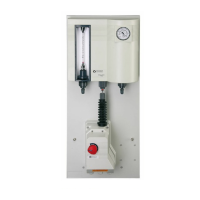V10k automatic 6. Maintenance
25
EN
6. Maintenance
• Maintenance of the gas control unit is
simplified if the following general precau-
tions are taken. These are easily followed
and will reduce costly maintenance and
repairs by providing good operating con-
ditions.
• Chlorine and sulphur dioxide gas, when
moist, are extremely corrosive. All metal
parts which normally come into contact
with moist gas are made from materials
which will withstand the corrosive action;
common metals are used only where the
part is exposed to dry gas. All connections
should be checked daily for signs of leaks.
Every leak must be rectified as soon as it is
discovered.
• The presence of a leak of chlorine or sul-
phur dioxide will be indicated by odour
and/or fume detection equipment, if sup-
plied. The exact location may be determi-
ned by ammonia vapour. Dense white
clouds of ammonium chloride form near
the leak in the presence of ammonia.
• When a connection is broken, if only for a
short time, the opening should be plug-
ged immediately to prevent the ingress of
moisture which should be excluded from
any part of the equipment normally expo-
sed only to dry gas.
• Water leaks must not be tolerated and
should be rectified as soon as they are
discovered.
• Whenever threaded plastic parts are
assembled, silicone type grease should be
used used to prevent the parts locking
together. In general, tools should not be
used to make up plastic connections, this
type of connection should be made up by
hand only.
• If the flowmeter tube, float, V-notch plug
or any valve seat becomes contaminated
with impurities sometimes found in gases,
it should be removed and cleaned.
• Replace all chlorine lines made of copper
every 2 years.
• Replace the auxiliary valves every 3 years.
• For safety reasons, we recommend that
you replace the chlorine pressure gauge
on the vacuum control valves (used to dis-
play the pressure in the chlorine cylinder)
every 5 years of operation. If the chlorine
pressure gauge leaks, is blocked, corroded
or damaged in any other way it needs to
be replaced immediately.
• Replace chlorine lines including the uni-
ons when they are damaged or corroded.
• Check the chlorine lines for leaks at least
every 6 months.
• Replace all o-rings and gaskets of the chlo-
rine system at least every year.
• Store the gaskets in a dry place. Wet gas-
kets lose their solidity forever and must
not be used again.
6.1 Changing the activated carbon
filter
The carbon has to be replaced when smelling
to chlorine or when lumped.
1 Remove the filter and open carefully.
2 If there is no smell of chlorine, stir the car-
bon powder and the ceramic rings and
check for lumps. If the powder is still in
WARNING
Danger due to chlorine gas !
Chlorine gas irritates the respiratory tracts.
Contact with chlorine gas in high concentra-
tions irritates and damages the membranes,
respiratory system and the skin. In extreme
cases death can result due to suffocation.
Before carrying out any maintenance opera-
tions involving dismantling, the system
should be cleared of gas. Follow procedure
at chapter 5.5.
When disassembling the system always put
on your gas mask.
WARNING
To avoid personal injury by electrical energy
only authorized and qualified electrical per-
sonnel may carry out works on electrical
parts of the system.
Before opening positioner, vacuum switch or
electric control unit, ensure that mains sup-
ply is switched off.
Assign repairs to the Evoqua service.
WARNING
Danger due to chemicals !
Chlorine loaded carbon reacts with water
generating hydrochloric acid. Don't pour into
water or pour water on it, but neutralize first!
Wear breathing equipment, eye protection
and protecting clothing!

